Kutz M. Handbook of materials selection
Подождите немного. Документ загружается.

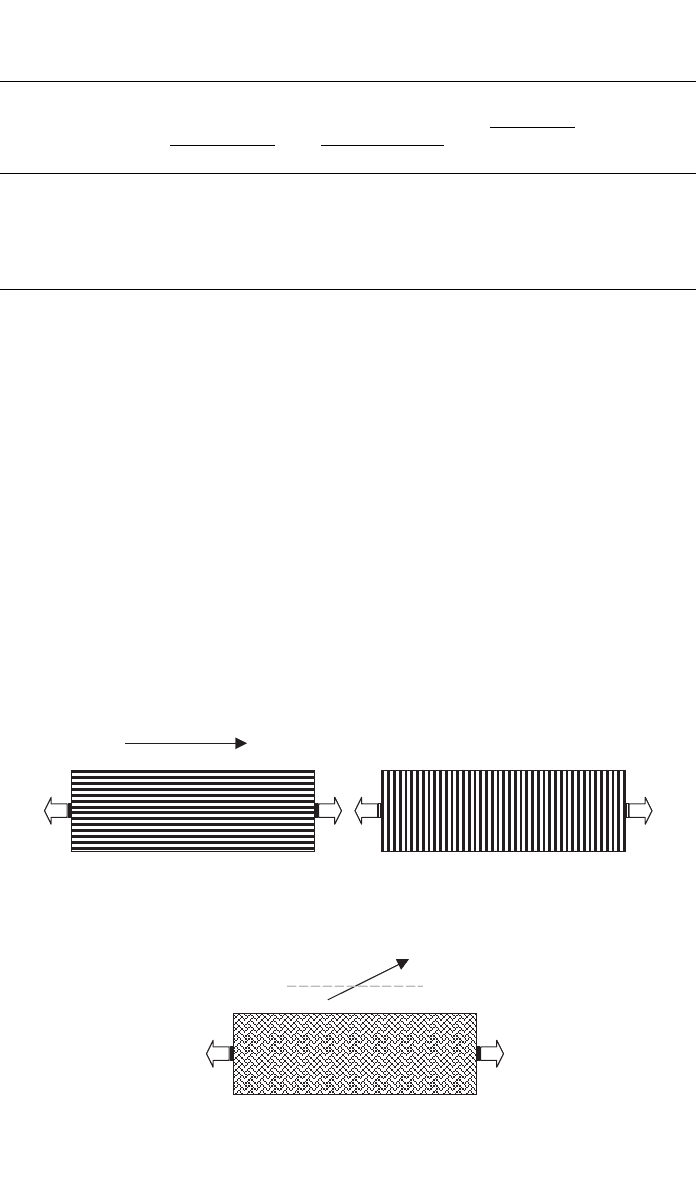
1382 COMPOSITES IN CONSTRUCTION
Table 1 Average Mechanical and Physical Values for Common Fibers for Composites
Used in Construction Repair Applications as Compared to Steel
Fiber Type
Average
Tensile
Strength
MPa ksi
Average
Tensile
Modulus
GPa Msi
Density
g/cm
2
(lb/ in.
3
)
Average
Elongation
(%)
E-glass 3450 500 72.50 10.50 2.54 (0.092) ⬎4.7
S-glass 4480 650 85.60 12.40 2.49 (0.09)
⬎5.2
Carbon 4825 700 228 33 1.80 (0.065)
⬎1.3
Aramid 3800 550 131 19 1.45 (0.052)
⬎2.5
Steel (AISI 1025) 394 57 207 30 7.80 (0.282) 0.12
a
a
Yield strain.
On-axis
Uniaxial Laminate
On-Axis Properties are Maximum
Transversally Reinforced Laminate
On-Axis Properties are Minimum
Off-axis
Multi-directional Laminate
On-Axis Properties are Lower Than Uniaxial Laminates and
Higher than Transversally Reinforced Laminates
Fig. 21 On-axis and off-axis mechanical properties of composite laminates.
is the ‘‘laminate’’ rather than ‘‘fibers’’ properties. Fibers and matrix properties
can also be used to predict some laminate mechanical properties, and these
results can be used to confirm the uniaxial FRP composite laminates properties
supplied by the manufacturer. In this case the civil engineer should have the
following information:
●
E
1ƒ
⫽ longitudinal fiber modulus
●
E
m
⫽ Longitudinal matrix modulus
●
12ƒ
⫽ Longitudinal Poisson ratio of the fibers
●
12m
⫽ Longitudinal Poisson ratio of the matrix
●
V
ƒ
⫽ fiber volume ratio
●
V
m
⫽ matrix volume ratio

2 CONSTRUCTION APPLICATIONS OF COMPOSITES 1383
The fiber and matrix volume fractions or ratios, V
ƒ
and V
m
, can expressed as:
Volume of fibers
V ⫽ (1)
ƒ
Volume of composite
Volume of matrix
V ⫽ (2)
m
Volume of composite
Knowing the ratios, V
ƒ
and V
m
, the void volume ratio can be calculated as:
Volume of voids
V ⫽ 1 ⫺ V ⫺ V ⫽ (3)
m ƒ
Volume of composite
The FRP laminate longitudinal and transversal mechanical properties can be
predicted using the following simple expressions (commonly called ‘‘rule of
mixtures’’):
E
⫽ VE ⫹ VE (4)
1ƒ1ƒmm
⫽ V
⫹ V
(5)
12 ƒ 12ƒ mm
EE
2ƒ m
E ⫽ (6)
2
VE ⫹ VE
ƒ mm2ƒ
where E
1
⫽ laminate longitudinal (major) modulus
E
2
⫽ laminate transverse modulus
12
⫽ laminate longitudinal (major) Poisson ratio
For simple unidirectional laminate tensile strength predictions, two cases
should be considered:
1. If ultimate tensile fiber strain ( is lower than ultimate tensile matrix
u
)
ƒ
strain ( ), i.e.,
u
m
uu
⬍ (7)
ƒ m
Accordingly, the laminate failure will occur when the composite laminate strain
reaches the tensile fiber strain. In this scenario, the laminate tensile strength can
be expressed by the following simple formula:
uu u
⫽
V ⫹ E V (8)
ttƒƒ m ƒ m
Assuming a composite laminate with relatively stiff fibers as compared to the
matrix, i.e., when E
ƒ
⬎⬎⬎ E
m
, Eq. 8 can be simplified further as:
uu
艑
V (9)
ttƒƒ

1384 COMPOSITES IN CONSTRUCTION
Table 2 Average Unidirectional Composite Laminate Room Temperature Mechanical
Values for Typical Composite Repair Systems Used in Construction Applications
Laminate
Composition
Typical
Laminate
Longitudinal
Tensile
Strength,
11
MPa ksi
Typical
Laminate
Longitudinal
Tensile
Modulus, E
11
GPa Msi
Typical
Laminate
Transversal
Tensile
Modulus, E
22
GPa Msi
Average Laminate
Elongation
(Rupture Strain)
%
E-glass/ epoxy 950 138 34.0 5.0 8.3 1.2 2.7
S-glass/ epoxy 1100 160 41.3 6.0 8.9 1.3 2.7
Carbon/ epoxy 1400 200 138.0 20 10.3 1.5 1.20
Aramid/ Epoxy 1300 189 65.0 9.5 5.5 0.8 2.0
Note: Based on 50% Volume Fraction; Fiber:Resin Volumetric Ratio 1:1
where
⫽
u
t
laminate longitudinal tensile strength
⫽
u
tƒ
fibers longitudinal tensile strength
2. If ultimate tensile matrix strain (
) is lower than ultimate tensile fiber
u
m
strain ( ), i.e.,
u
ƒ
uu
⬍ (10)
m ƒ
In this case, the laminate failure will occur when the composite laminate strain
reaches the tensile matrix strain. The laminate tensile strength can approximately
be calculated using the following simple formula, which does not account for
the statistical distribution of fiber and matrix strengths:
uu
艑
(V
⫹ V ) (11)
ttmƒ m
where ⫽
u
tm
matrix l tensile strength
⫽ fiber/matrix stiffness ratio (modular ratio) given by:
Eƒ
⫽ (12)
E
m
Table 2 presents some average mechanical values for typical FRP composites
repair systems. It should be noted that these values are based on 50% volume
fraction. In reality, and especially for wet lay-up field applications, the typical
expected volume fraction ranges from 35 to 45%. For this reason, the values
presented in Table 2 may be reduced accordingly using Eqs. 4–12. It is strongly
recommended that the civil engineer require random sampling and American
Society for Testing and Materials (ASTM) tensile coupon tests from different
patches mixed at the site in order to verify the design-based mechanical prop-
erties and to allow for design modifications based on actual field properties of
the FRP composite system. A comprehensive document describing these pro-
cedures, called AC178 (ICBO, 2001a), has recently been approved and published
by the International Conference of Building Officials (ICBO). The engineer is

2 CONSTRUCTION APPLICATIONS OF COMPOSITES 1385
advised to review this important document during the design process as well as
during the construction phase for quality control and quality assurance of the
composite repair system.
Preimpregnated (Prepreg) Composite Systems. Preimpregnated laminates
(prepreg system) are also available commercially for construction repair appli-
cations. In this case, dry fabrics are preimpregnated with resin at the controlled
shop conditions. Unlike the wet lay-up system, where the composite laminates
are fabricated and cured at the site, the prepegs are fabricated at the shop and
cured at the construction site. Prepreg composite repair system requires heat
blankets for curing the prepreg laminates, which is one of the disadvantages of
this system, especially at remote areas and for complex geometry of the struc-
tural members to be repaired. In addition, the useful life of such systems is
limited and dependant on the storage environmental conditions.
Prefabricated Composite Laminates or Shells. In this method, the fibers
are in the form of either unidirectional strips, shells, or sandwich panels. In the
case of flat members such as beams and slabs, prefabricated unidirectional com-
posite strips are bonded to the specified locations using epoxy after surface
treatment. The common manufacturing process for the prefabricated composite
flat strips is called ‘‘pultrusion,’’ which is a continuous process that will be
explained later in this chapter. However, several other manufacturing processes
are also available for fabricating these strips including press molding, resin trans-
fer molding, and others. In all cases, the average fiber volume fraction for com-
mercially available composite strips is about 65%. The procured unidirectional
composite laminates are commonly delivered to the construction site in the form
of large flat stock or coiled on a roll for thin laminates. A peel ply is preferred
when the surfaces are pretreated to ensure clean bond surface at the time of
application.
In applying the prefabricated strips, sanding or removal of the outmost matrix-
rich layer is performed to ensure sufficient bondline strength between the com-
posites and the concrete surface. To verify the bondline strength, a pullout field
test is often required by the engineer of record (refer to Fig. 22).
For columns repair, prefabricated shells with majority of fibers in the hoop
direction are used. After surface preparation, a thin coat of epoxy is applied,
and the shell is placed at the required location per the engineering drawings.
Straps are used to squeeze out any excess resin (Fig. 23). It is critical that the
split lines be staggered with a phase angle of 90
⬚.
Automated Machine Lamination. In this method, the fibers are either dry
or preimpregnated. Thermal blanket or mobile curing oven is usually used to
achieve the complete cure of the composite laminate (Fig. 24). Following the
initial curing process, textured urethane-based paint is hand applied over the
cured laminates, which provides ultraviolet (UV) protection of the composites.
Design Considerations for FRP Composite Repair
One of the major issues that the structural engineer should clearly identify is
the state of the existing underdesigned or diffident member. This includes the
existing and expected future loads, as well as the extent of damage and/or
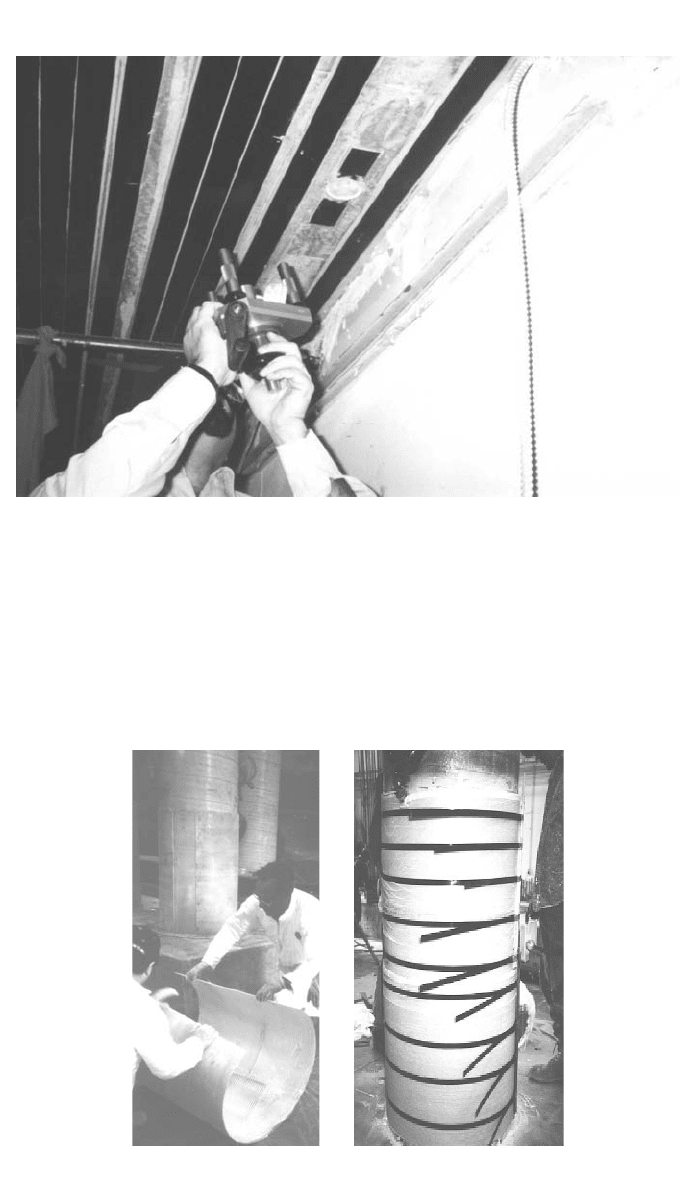
1386 COMPOSITES IN CONSTRUCTION
Fig. 22 Prefabricated composite laminate R/ C slab applications and on-site bondline strength
test. [Courtesy of Structural Composites Construction Inc. (SCCI)]
Fig. 23 Hard shell precured composite retrofit system.
(Courtesy of Professor M. Haroun, University of California, Irvine)
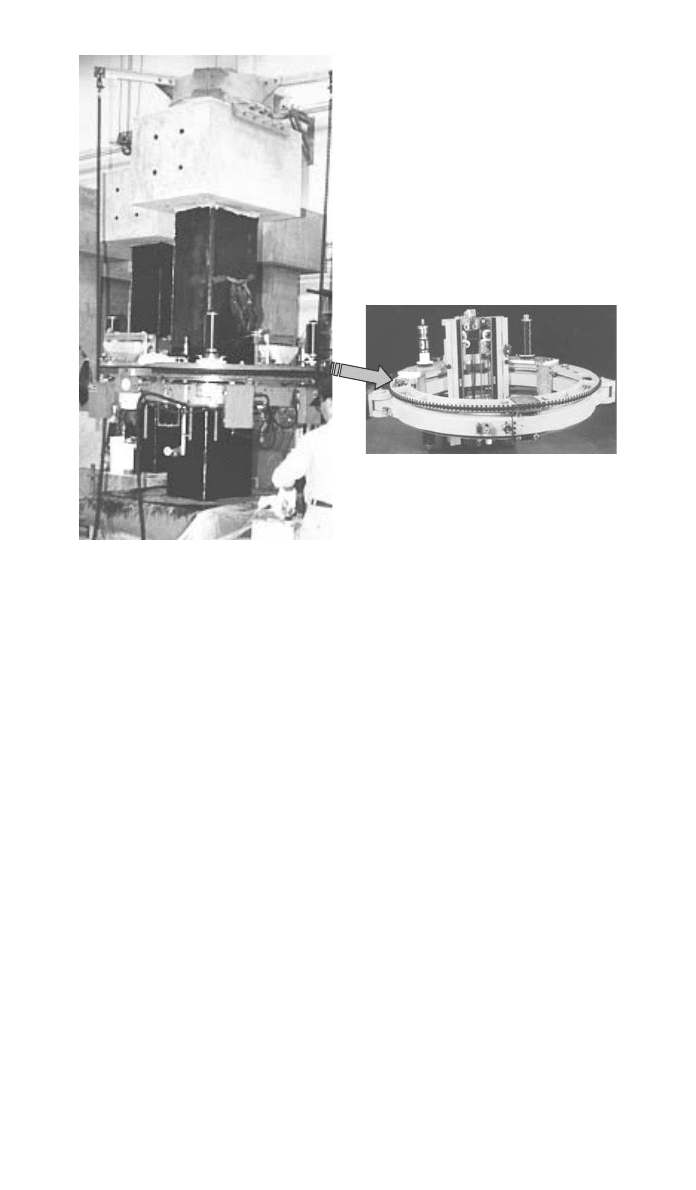
2 CONSTRUCTION APPLICATIONS OF COMPOSITES 1387
Fig. 24 Automated machine lay-up for bridge column retrofit applications.
(Courtesy of Professor M. Haroun, University of California, Irvine)
structural deficiency of the structural members. This includes the residual
strength of the concrete that can be determined by testing random core samples
from the member to be repaired to instigate the feasibly of using the composites,
as well as to determine the type and required specifications for the resin (for
wet lay-up systems) or the adhesive (for prefabricated systems) and the type and
viscosity of the primer to be used prior to the application of the composite
laminates. The next step is the identification of the environmental exposure of
the structure. This step is very critical in the selection process for fibers, resin
system, required additives (e.g., the requirements of adding UV inhibitors for
outdoor applications and fire-retardant additives for indoor applications), as well
as the preferred fabrication process of the composites. The structural engineer
should identify the locations of damages, for example, in a reinforced concrete
member, the locations and quantity of the damaged steel reinforcements should
be defined in order to calculate the structural demands for different types of
stresses using the appropriate FRP composite repair system. Also, the engineer
should quantify the limit state for her/his design in order to specify the efficient
composite repair system.
For example, if the main concern were the loss of stiffness, the carbon-based
composites would be the preferred choice in this case. On the other hand, if the
ductility enhancement for seismic applications is the design objective, glass-
based FRP composites would be appropriate to the inherent lower longitudinal
stiffness modulus of the materials. Of course, both materials can be used, but
the question is the efficiency and the reliability of the system, which is the sole
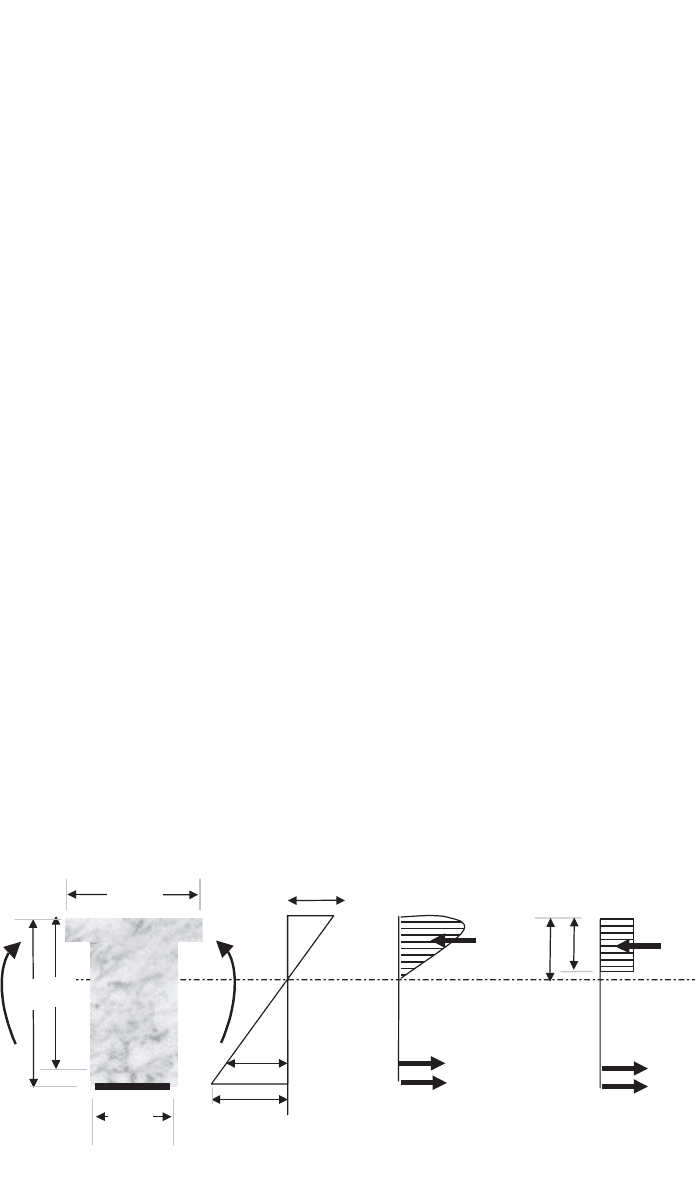
1388 COMPOSITES IN CONSTRUCTION
T
FRP
•
••
C
T
s
T
FRP
T
s
C
c
a
b
f
b
w
h
d
A
s
M
ε
c=0 003
ε
s
ε
FRP
M
Fig. 25 Distribution of flexural strain and stresses at ultimate for concrete beam reinforced in-
ternally with tension steel and externally with FRP composite laminate(s).
responsibility of the engineer of record. Another issue that should be analyzed
beforehand is the creep rupture effects of the FRP composite repair system,
particularly for both glass-based and aramid-based composite systems. In this
case, a knockdown factor, relatively higher than that for carbon-based compos-
ites, should be used to avoid any potential failure due to the exposure to sus-
tained loading conditions. In determining these knockdown factors, several
parameters should be considered, including the stiffness and strength degradation
due to the exposure to aggressive environments, as well as the strain rate and
the type of application. For example, composite jackets used for ductility en-
hancement, often called ‘‘contact-critical’’ application, will undergo a light strain
level until the application of the seismic forces. In this case, a lower creep
rupture (or static fatigue) knockdown factor may be used. On the other hand, a
composite system applied at the bottom surface of a reinforced concrete beam,
often called ‘‘bond-critical’’ application, especially if the a cumber has been
introduced to the beam before complete cure of the composites, will be exposed
to a relatively higher state of strains. In this case, a relatively higher creep rupture
knockdown factor should consider. In this particular example, the carbon-based
composite system is the preferred choice.
Design Philosophy of FRP Composite Repair of Reinforced Concrete
and Masonry Structures
Flexural Capacity Upgrade of Concrete Members. As mentioned earlier,
one of the major tasks in designing with FRP composites is the strength assess-
ment of both concrete and steel reinforcements as well as the present stress
conditions. The major design criterion for FRP repair of reinforced concrete
structures is based upon the strain compatibility principles. FRP composites have
different thermomechanical properties as compared to concrete. Upon loading,
the strain developed in the concrete, steel, and composites are assumed to follow
a linear pattern (refer to Fig. 25).
Following the ACI318 ultimate strength code procedure, the factored moment
should be larger than or equal to the ultimate bending moment of the section,
i.e.,

2 CONSTRUCTION APPLICATIONS OF COMPOSITES 1389
M ⱖ M (13)
nu
where
⫽ strength reduction factor, which depends on ductility of ultimate
mode of failure and type of stresses (if failure is ductile, i.e., internal
steel yielded at time of failure of FRP composites, typical value of
0.9 can be used, otherwise value should be reduced to account for
brittleness of ultimate failure)
M
n
⫽ nominal or predicted moment
M
u
⫽ ultimate moment capacity of the section
The strain compatibility condition can be derived using the linear strain distri-
bution in Fig. 25, and assuming
●
the ultimate strain of concrete in compression is 0.003,
●
the tensile strength of concrete in tension is ignored, and
●
strain distribution along the depth of the beam is linear,
then
h
⫺ c
ult
⫽ 0.003 ⱕ
(
⬍ 1) (14)
冉冊
FRP FRP
c
Here:
●
The reduction factor
is used to prevent delamination of bondline failure.
For design purposes, this factor should be taken less than unity and the
upper bound depends on the type of the FRP system.
●
The strain developed in the laminate at ultimate, , may be reduced if
FRP
the existing member is exposed to existing service loads, which generates
another existing strain component
ext
(refer to Fig. 26). In this case,
h
⫺ c
ult
⫽ 0.003 ⫺ ⱕ
(15)
冉冊
FRP ext FRP
c
●
The term is the ultimate or rupture strain of the FRP composites.
ult
FRB
Based on the strain compatibility condition and the ACI318-99 procedure
(ACI, 1999), the ultimate moment capacity of the strengthened section is given
by
M
⫽ A ƒ(d ⫺ 0.5a) ⫹ A ƒ(h ⫺ 0.5a) (16)
nsx FRP FRP
where A
s
⫽ area of tension steel
ƒ
s
⫽ stress in steel at ultimate
ƒ
FRP
⫽ stress in the FRP laminates
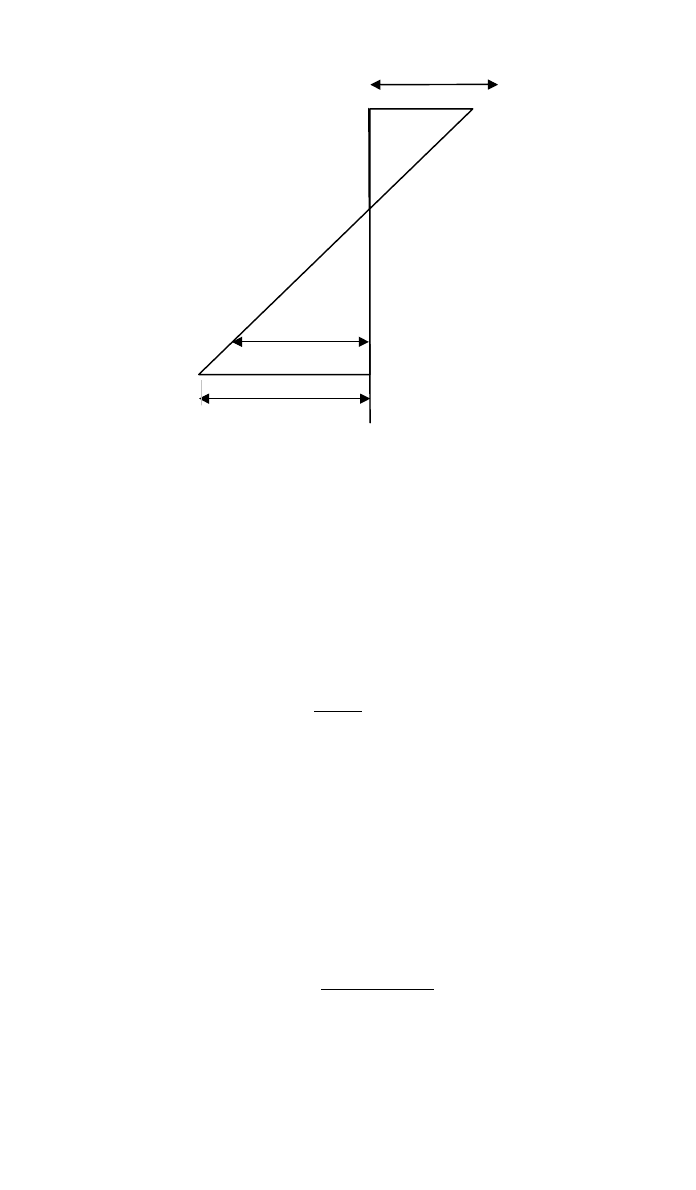
1390 COMPOSITES IN CONSTRUCTION
ε
c=0.003
ε
s
ε
total
=
ε
FRP
+
ε
ext
Fig. 26 Total tensile flexural strain when FRP repair applied while the member is loaded.
a ⫽

1
c

1
⫽ ratio of the average concrete compressive stress to the maximum
stress. For concrete compressive stresses ƒ , the factor

1
shall be⬘
c
taken as

⫽ 0.85 for ⱕ4000 psi (17)
1
ƒ⬘
c

⫽ 1.05 ⫺ 0.05 for 4000–8000 psi (18)
1
1,000

⫽ 0.65 for ⬎8000 psi (19)
1
Similar procedure for predicting the flexural strength of FRP externally re-
inforced concrete and masonry members is described in the ICBO AC125 (2001)
document. According to ICBO AC125 (ICBO, 2001), the flexural strength gain
(the component T
FRP
in Fig. 22, which is referred to ⌬ F in the Eq. 20) can be
calculated using the following equation:
2
t cos
ƒ
ƒ jƒ
⌬F ⫽ (20)
unit
⫺ width
where t
ƒ
⫽ thickness of the FRP laminates
⫽ angle of fiber direction to member axis
ƒ
jƒ
⫽ confining strength of FRP composites calculated by following equa-
tion:
2
ƒ ⫽ E cos
ⱕ
ƒ (21)
jƒ ƒƒ uj

2 CONSTRUCTION APPLICATIONS OF COMPOSITES 1391
Table 3 Recommended Values of (in Eq. 21) for Different
FRP Composite Systems
a
FRP Composite System Recommended Reduction Factor,
Carbon/ epoxy 0.50
E-glass/ epoxy 0.30
Aramid/ epoxy 0.35
a
These values are based on room temperature environment. For higher
service temperatures and/ or severe environments, these values shall be
reduced.
where E
ƒ
⫽ tensile modulus of elasticity of FRP composites
ƒ
⫽ composite material strain at designated strength
⫽ strength reduction factor dependent on type of composites.
This factor is taken as 0.75 for all composites in the original ICBO AC125
[ICBO, 2001b, equation (1), section 7.3.2.1]; however, it is strongly recom-
mended to have different values for different composite repair materials to avoid
creep rupture in the polymeric composite laminate(s). Table 3 presents the rec-
ommended values of
for different FRP composite systems.
Detailed information on design procedures can be found in Nanni and Gold
(1998), Mosallam et al. (2000), and ICBO AC125 (ICBO, 2001b). Analytical
modeling of special applications of concrete slabs retrofit with composites is
reported by Mosalam and Mosallam (2001).
Minimum Bond Strength Requirements. For repair applications where the
structural performance of the composite system depends largely on the bondline
strength of the composites to the concrete or masonry (often called bond-critical
applications such as beams, slabs, and walls), the ICBO AC125 (ICBO, 2001b)
requires that under ultimate flexural strength conditions, the bond stress devel-
oped between the composites and concrete or masonry rate of change shall not
exceed:
d(t ƒ)
ƒ j
u ⫽ ⱕ 0.75ƒ (22)
ut
dx
where u
u
⫽ bond stress between FRP composite laminates and concrete or ma-
sonry
t
ƒ
⫽ composite laminate thickness
ƒ
j
⫽ laminate stress
x
⫽ direction parallel to the fibers
The term d(t ƒ
j
)/dx describes the rate of change of the fibers net force (t
ƒ
ƒ
j
)
ƒ
with respect to the distance (x) parallel to the major fiber direction. Equation 22
should be evaluated at sections where this rate is maximum, which is normally
at the ends where maximum shear stresses exist. For comprehensive coverage
